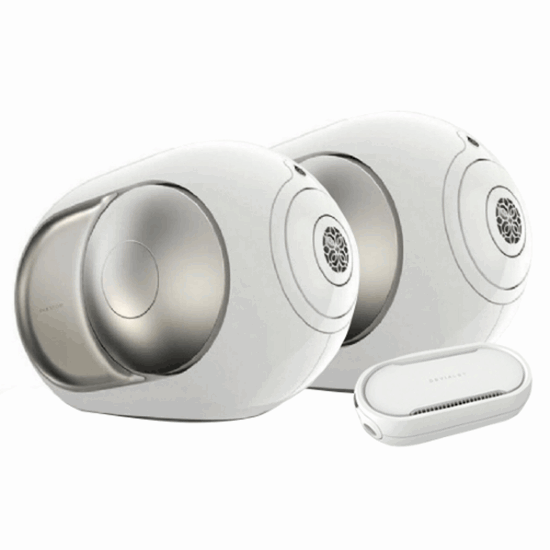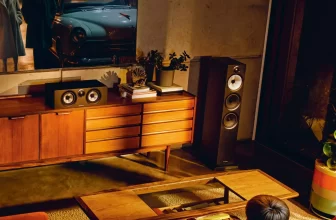Devialet Silver Phantom Duo Review: The best speakers you’ve never heard of

Devialet Silver Phantom Duo Review – Bulging eyes, gaping mouths, peers turning for double-takes, and sometimes even looks of confusion: That was our observation of facial reactions when testing Devialet’s Silver Phantoms.

[sc name=”Youtube”]
Describing audio performance is difficult. Should we wax poetic about how something sounds? Words such as air, stage, warm, smooth, rich—they don’t really mean anything. So perhaps a good descriptor would instead be how people react when they hear it.
The Phantom is a speaker designed by French outfit Devialet. Haven’t heard of it? That’s OK, we hadn’t either. Unless you’re inside specific circles of the audiophile community, Devialet is a name few will recognize, but it’s revered for designing amplifiers for loudspeakers that go against conventional design principles.
About the size of two toasters, the Phantom looks anything but conventional— maybe more like an alien probe. But Devialet is adamant that despite its size, the Phantom can replace a hi-fi system costing. And if you asked anyone who’s listened to the Phantoms, you might start believing so, too.
There are three main technologies in the Phantom: speaker active matching (SAM), analog-digital hybrid (ADH), and heart bass implosion (HBI).
Let’s start with SAM. Devialet measures movements of a speaker driver with lasers, then uses the information to mathematically map the driver. The result is speaker movement that’s precisely controlled, no matter what the volume is set to or what the audio content is. For Phantom, Devialet says it’s able to play at maximum volume without distortion and without loss of fidelity. In other words, the Phantom sounds awesome at all levels.
ADH is how the Silver Phantom delivers 3,000 watts of power. Using a combination of Class A and Class D amplifiers, the Phantom can dish out 105dB of sound pressure—enough to rock an entire nightclub. High-end speaker amps often employ Class A designs because the fidelity is high. The drawback is that Class A amps run hot due to inefficiency. This is where Class D amps come in—they’re highly efficient and powerful, but they lack fidelity. With ADH, Devialet combines both technologies to produce powerful—extremely loud—and clean audio.
Then we come to the final, and arguably most impressive, technology: the HBI system. It’s the two fisheye drivers on either side of the Phantom, which are responsible for bass. And what glorious bass the Phantoms produce.
Frequency responds down to a mind-boggling 16 Hz. In case you’re wondering, this is low—lower than most home theater subwoofers could ever dream of going. Humans can hear down to 20Hz, but the Phantom’s bass extension drills down to subsonic levels. Yes, you can feel the Phantoms.
“I’ve got a massive subwoofer with a 16-inch driver that can do that,” you say?
Great! Except, the Phantom is only six liters in volume—compare that with your monster 100-liter subwoofer. If you’ve got a smaller sub or large floor-standing speakers, the Phantom will punch a hole through the floor and bury them.
This is where we get to the head scratching reactions of listeners. Everyone, and we mean everyone, gawks in awe as the Phantom plays. They ask questions such as, “How is that thing making that kind of sound?” Or simply, “What the *@#$?!”
The Phantoms simply defy conventional speaker design principles. To deliver really low frequency extension at good volumes, a speaker cabinet needs to contain volume because lots of air mass needs to be moved. This is precisely why subwoofers that have very low frequency responses need to be designed large. Forget the subwoofer that came with your PC desktop; those aren’t what we’d consider real subwoofers.
The Phantoms sound good with all genres of music, as well as movies. The real test is playing tracks with deep bass. More often than not, when speakers are cranked up, the bass will wreak havoc on the rest of the audio spectrum. Mids become unclear and highs are drowned out. Not so with the Phantoms. Here, SAM works so well that we perceived no dips in frequency response. Without using expletives—and believe us, we want to—the Phantoms are simply jaw-dropping.
What about stereo imaging? The problem is, you need two Phantoms to produce stereo. You can buy one Phantom, which still sounds phenomenal and has no issues filling large rooms, but it’ll only operate in mixed-mono mode. To get stereo, you’ll also need to purchase Devialet’s Dialog, which is a wireless control unit that the Phantoms connect to wirelessly. In fact, the Dialog can control up to 24 individual Phantoms—one for each room of your mansion.
There are two models: the vanilla Phantom, which is white, with 750 watts producing 99dB, and the Silver Phantom. The Silver dishes out 3,000 watts at 105dB. Lest there be any doubt, 105dB is the legal limit for a club.
We’ve demoed the Phantoms to about 18 people now. All their reactions have been the same: mind-blown. The cost of this experience? Can the Phantoms replace our multi-thousand dollar home theater system? No. They destroy it.





